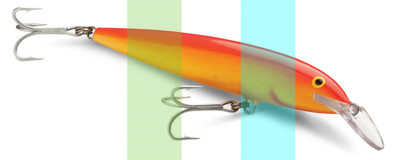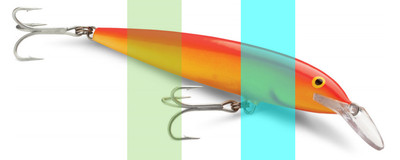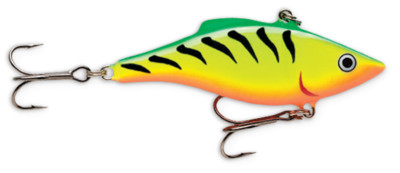Computer modeling: how saltwater fish perceive some colored lures underwater
The Rapala company offers to catch freshwater and saltwater predatory fish artificial lures with various fluorescent colors.
About fluorescent color patterns, see, for example:
https://www.rapala.com/rapala/lures/magnum-lures/floating-magnumandreg/Floating+Magnum.html
However, in the development of these lures the Rapala company does not consider achievements of the sensory ecology, which studies, in particular, the optical properties of water environments and how fish perceive different colors (if the fish have color vision) underwater. Therefore, the Rapala company does not correctly determine the palette of suitable fluorescent colors and does not correctly positioned in the consumer market lures with such colors as exceptionally attractive and effective to catch freshwater and saltwater predatory fish.
For example, the Rapala company offers for freshwater and saltwater predatory fish lures with the color pattern named “Gold Fluorescent Red” (see Fig. 1).
It is known that fresh water absorbs short-wavelength rays and transmits long-wavelength rays, so the maximum of spectral sensitivity of eyes of freshwater fish is shifted to the orange and red parts of the optical spectrum (e.g., Tamura & Niwa, 1967). Therefore, the “white light” for freshwater fish is enriched with the long-wavelength rays (we name this light as “worm light” or “warm white”). In contrast, marine water absorbs long-wavelength rays and transmits short-wavelength rays, so the maximum of spectral sensitivity of eyes of saltwater fish is shifted to the blue and green parts of the optical spectrum (Tamura & Niwa, 1967). Therefore, the “white light” for saltwater fish is enriched with the short-wavelength rays (we name this light as “cool light” or “cool white”).
For more information how fish perceive colors, see Vorobyev et al. (2001).
It means that lures with the color pattern “Gold Fluorescent Red” are theoretically suitable for freshwater environment and are not suitable for saltwater environment. Lures with this color pattern save red color, when observed through yellow-and-green water column (the case of freshwater environment), and loss red color, when observed through blue water column (the case of saltwater environment) (see Fig. 1).


Fig. 1. Rapala’s lures with the color pattern “Gold Fluorescent Red” observed through yellow-and-green and blue optical filters (at the top the single blue filter and at the bottom the double blue filter).
On the other hand, the Rapala company positions in the consumer market lures with the color pattern “Gold Fluorescent Red” as attractive and effective to catch freshwater and saltwater predatory fish. Note, this color pattern is similar to another Rapala’s color pattern named “Fire Tiger” (see Fig 2). However, Wilde et al. (2003) have shown in the field experiments that lures with the color pattern “Fire Tiger” are less effective than lures with the natural color patterns “Blue Shiner”, “Brown Trout” and “Fathead Minnow”.

Fig. 2. Rapala’s lures with the color pattern “Fire Tiger”.
Basic references
Tamura T., Niwa H. 1967. Spectral sensitivity and color vision of fish as indicated by S-potential. Comparative Biochemistry and Physiology 22, 745-754
Vorobyev M., Marshall J., Osorio D., de Ibarra N.H., Menzel R. 2001. Colourful objects through animal eyes. Color Research & Application 26, S214-S217
Wilde G.R., Pope K.L., Durham B.W. 2003. Lure-size restrictions in recreational fisheries. Fisheries 28, 17-26






